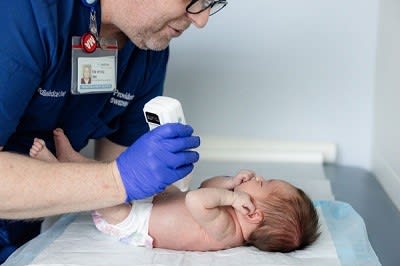Teenage girls and depression

[3 MIN READ]
In this article:
- Research shows teenage girls are feeling slightly less depressed than they did during the COVID-19 pandemic. However, more than half still report persistent feelings of sadness or hopelessness.
- Signs of depression in adolescent girls include extreme irritability, intense sadness and loss of interest in activities they once enjoyed.
- A clinical social worker at Swedish talks about depression in teenage girls and offers tips to help parents and caregivers create an atmosphere of trust, understanding and support.
According to research conducted during the COVID-19 pandemic, teenage girls were experiencing record levels of depression.
The news was worrisome. However, recent findings indicate that teenage girls are feeling slightly less depressed and anxious than they did during the initial period of the pandemic. But according to a report from the U.S. Centers for Disease Control and Prevention (CDC), they still have a long way to go.
Every two years, researchers from the CDC publish results from the Youth Risk Behavior Study. The biennial report features data on the experiences and behaviors of high school students in the United States. It focuses on several areas, including teens’ mental health, experiences of violence, sexual behavior and suicidal thoughts and behaviors.
In the 2021 study, depression in teenage girls reached a record high of 57%, with more than half of all female participants reporting they had experienced persistent feelings of extreme sadness and hopelessness. The most recent report shows those numbers have since dropped to 53% – a small but significant change, according to Violet Resnick, LICSW, MPH, a clinical social worker at Swedish.
“A drop from 57% to 53% is notable,” says Resnick. “I think it could be due to improved access to mental health care and increased willingness to seek help, as the stigma around mental health is decreasing. We’re also slowly trying to change cultural norms and expectations, which affect teenage girls more emotionally.”
What is teen depression?
It’s normal – maybe even expected – for an adolescent girl to feel anxious or sad occasionally. But if her bad mood lingers for several weeks or longer, it could be a sign of depression. Depression is considerably more than a bit of grumpiness after a bad day. Depression often includes intense feelings of sadness, anger, frustration and hopelessness that persist for several weeks or longer.
What causes depression in teen girls?
Depression can happen to anyone at any age, but it often begins during the teen years or early childhood, according to the National Institutes of Health. Many factors, including genetics, hormones, brain biology and personal life experiences, play a role. Stressful childhood events like the death of a loved one, bullying or abuse also contribute to depression in teen girls.
Your teen may be at greater risk for depression if she has:
- Other mental health conditions, such as anxiety or an eating disorder.
- Serious illnesses such as cancer, heart disease or diabetes.
- Family history of mental illness.
- Poor or dysfunctional family relationships.
- Difficulty interacting with people.
- Learning disabilities or attention deficit hyperactivity disorder.
- Experienced trauma.
- Low self-esteem or poor coping skills.
Impact of social media
Social media plays a significant role in an adolescent’s life, in both positive and negative ways, says Resnick.
“Teens, regardless of gender, spend a lot of time online, which means they are exposed to more content. Some of it’s good. Some of it’s overwhelming,” she says. “There’s a lot of pressure to look or act a certain way, especially regarding physical appearance. Girls and women tend to be more preoccupied with how others perceive them, which can lead to peer pressure to conform and, ultimately, depression.”
BIPOC and LGBTQ youth
Depression is also a significant health threat for many BIPOC and LGBTQ teens.
“Rates tend to be worse for LGBTQ teens because they face additional stigma and identity struggles. They may feel like they don’t have a safe space. Similarly, teens of color often lack access to mental health resources and are sometimes overlooked compared to their white peers. These factors can make their mental health outcomes worse,” explains Resnick.
Recognize the warning signs
Everyone gets a little moody sometimes, and girls ages 12 through 18 are no exception. How do you know when your teen is having more than “just” a bad day?
“Look for changes in appetite, a loss of interest in activities they used to enjoy or shifts in their peer and friendship groups,” says Resnick. “If they’re withdrawing from family or social life, that could be a red flag.”
According to the American Academy of Child and Adolescent Psychiatry, symptoms of depression in adolescents include:
- Feeling or appearing tearful, sad or irritable.
- Loss of interest in extracurricular activities they used to enjoy.
- Spending less time with friends.
- Avoiding school or school activities.
- Changes in weight, eating habits or appetite.
- Sleeping more or less than usual.
- Increased fatigue and reduced energy.
- Feeling like they are not good enough at anything they attempt.
- Difficulty concentrating.
- Thoughts of suicide or self-harm.
Be curious, not critical
Although talking to a teenage girl can sometimes feel like conversational bungee jumping, it’s essential to keep the lines of communication open and take the plunge on a regular basis.
“I think it’s essential to focus not only on short-term solutions but also on creating a more open, communicative environment in the long term,” says Resnick. “Engaging your teens in activities they enjoy can help build trust and communication. Setting firm boundaries while including your teen in conversations about rules – like screen time – can foster cooperation and respect. Rather than imposing rules, ask them what they think is appropriate and go from there.”
These tips from the National Institutes of Health will help get you started:
- Give your teen support and let them know you’re there for them.
- Listen more than you talk. Try not to give too much advice or overwhelm your teen with questions.
- Schedule your family life to help your teen get plenty of sleep.
- Watch for signs that your teen’s depression is getting worse, and have a plan if it happens.
- Encourage your teen to exercise regularly and participate in sports or other physical activities they enjoy.
- Find a good therapist or counselor if your teen feels talk therapy would help improve her mental health.
- Talk to your teen’s doctor about antidepressant medication and whether it would be effective in this situation.
“Parents should approach these situations with empathy rather than judgment because teens are developmentally in a phase where they push boundaries and form their own identities,” says Resnick. “Curiosity works better than criticism here.”
Learn more and find a physician or advanced practice clinician (APC)
Whether you require an in-person visit or want to consult a doctor virtually, you have options. Contact Swedish Primary Care to schedule an appointment with a primary care provider. You can also connect virtually with your provider to review your symptoms, provide instruction and follow up as needed. And with Swedish ExpressCare Virtual, you can receive treatment in minutes for common conditions such as colds, flu, urinary tract infections and more. You can use our provider directory to find a specialist or primary care physician near you.
Information for patients and visitors
Related resources
How to talk to your kids about drugs and alcohol
Debunking the myths about teen antidepressant use
This information is not intended as a substitute for professional medical care. Always follow your healthcare professional's instructions.


